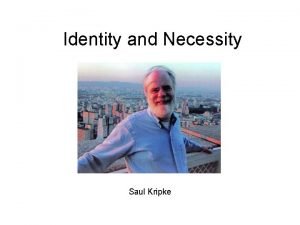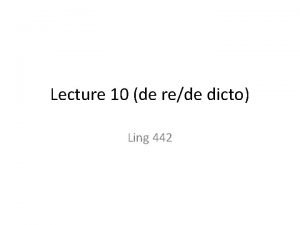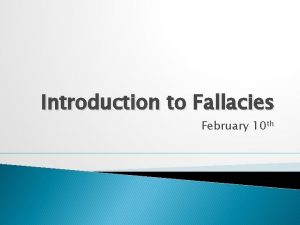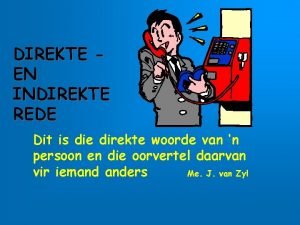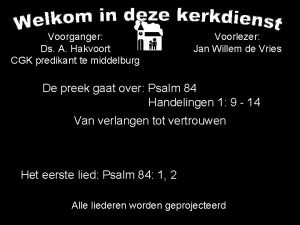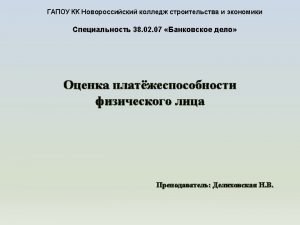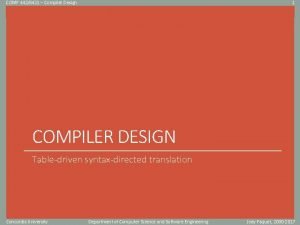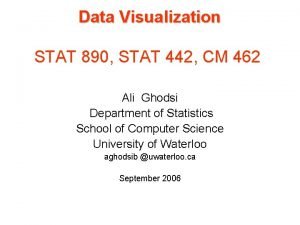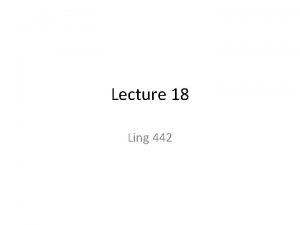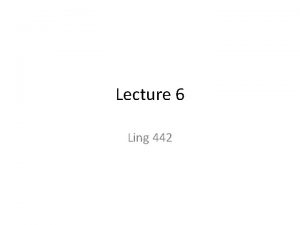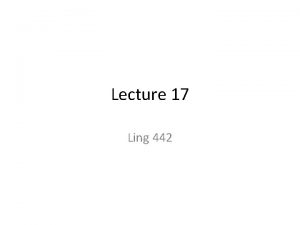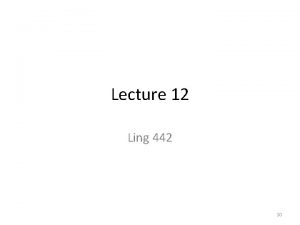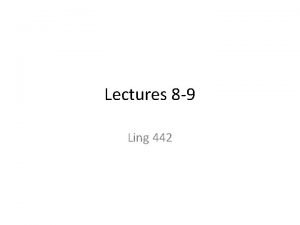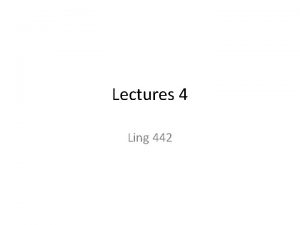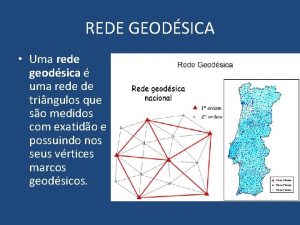Lecture 10 de rede dicto Ling 442 Exercises



![Semantics of modal verbs (1) �deontic x y [respect (x, y)] (2) (1) is Semantics of modal verbs (1) �deontic x y [respect (x, y)] (2) (1) is](https://slidetodoc.com/presentation_image_h/0ce96a088451770c9a97ca618c96f5c6/image-4.jpg)







- Slides: 11

Lecture 10 (de re/de dicto) Ling 442

Exercises • Translate the following into the logical language w/ restricted quantifiers. 1. Every dog that has a bone is happy. 2. Every person who owns a house invited some celebrities. 3. An apple in every basket is rotten.

Conservativity: D is said to be conservative iff �D N VP�= �D N is a N that VPs� • More precisely, when calculating the truth condition of a sentence of the form D N VP, use �N� �VP� wherever the original truth conditions require �VP� and see whether the same truth conditions are preserved. • If this has no effect on the truth conditions, then the determiner D is said to be conservative. • All “regular” determiners are conservative, but only is not presumably because it is not a determiner.
![Semantics of modal verbs 1 deontic x y respect x y 2 1 is Semantics of modal verbs (1) �deontic x y [respect (x, y)] (2) (1) is](https://slidetodoc.com/presentation_image_h/0ce96a088451770c9a97ca618c96f5c6/image-4.jpg)
Semantics of modal verbs (1) �deontic x y [respect (x, y)] (2) (1) is true in w 0 iff in all worlds w that conform to an appropriate set of rules in force in w 0, , x y [respect (x, y)] is true. (3) ◊deontic smoke_here (you) (4) (3) is true in w 0 iff in some worlds w that conform to an appropriate set of rules in force in w 0, , smoke_here(you) is true.

Semantics of (non-material) conditionals Epistemic conditionals: (1) If Oswald did not kill K. , then someone else did. (2) (1) is true in w 0 iff in all worlds w’ that conform to what the speaker believes/knows in w 0, O did not kill K is false, or Someone else killed K is true. Note: Given that the accessible worlds all conform to what the speaker knows/believes, s/he is NOT certain that O killed K.

Semantics of (non-material) conditionals Counterfactual conditionals: (3) If Oswald had not killed Kennedy, someone else would have. (4) (3) is true in w 0 iff in all worlds w that are closest from w 0 among those in which O. did not kill K. is true, someone else killed K is true. Note: Given that in counterfactuals, the antecedent is almost always FALSE in the actual world, the speaker believes/knows that O. killed K.

De dicto vs. de re 1. John believes that the President of UW is a nice person. 2. Mary is looking for the President of UW. • (1) and (2) have two readings each.

Examples (1) Clive wants to visit the university where Chomsky received his Ph. D. (2) Mary is looking for the plumber that John hired and liked. (3) Clive visited the university where Chomsky received his Ph. D. (4) Mary kissed the plumber that John hired and liked.

The semantics of believe, look_for (1) Mary believes S is true in w 0 iff in all worlds w that conform to what Mary believes in w 0, S is true. (2) Mary looks for the NP is true in w 0 iff in all worlds w in which Mary finds what she is looking for in w 0, Mary finds the NP. (This is very rough. )

Specific vs. non-specific • Mary wants to marry a Canadian. • John is looking for a plumber.

“opaque” contexts Some predicates (believe, look for, need, want) produce a context in which two expressions denoting the same object (for example, two definite descriptions referring to the same entity) do not necessarily produce the same reading. (But note that this is only true of de dicto readings of the expressions in quesiton. )
